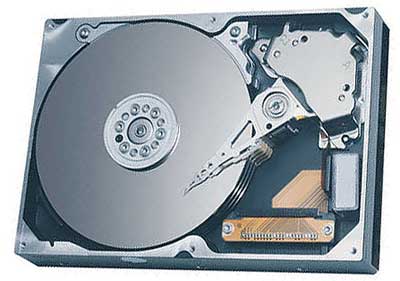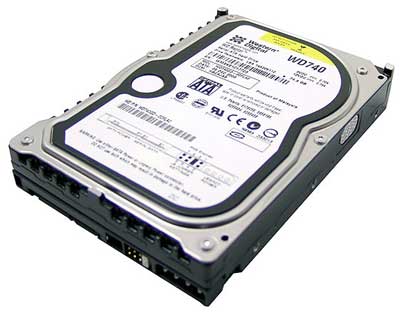Buyer's Guide - Mid-Range, October 2004
by Jarred Walton on October 21, 2004 11:00 AM EST- Posted in
- Guides
Hard Drive Recommendations
With our budget requirements, the one thing that we are definitely looking for in any hard drive is a SATA interface. The cables are much easier to work with and do not restrict air flow as much as the old IDE cables, and the price difference is negligible. Note also that many of the newer Intel motherboards only include one IDE port, which will usually be used for optical drives. As for what people will need, we feel that content creation work definitely requires a lot of hard drive space, as complex images and movies can rapidly fill up even the largest of hard drives. Software development is probably the least demanding in terms of space, so a smaller drive is usually more than sufficient. For frequent compiling of large projects, a faster hard drive subsystem can definitely improve performance, which is something to consider.The subject of RAID often comes up when discussing hard drives and we will continue to stick with our opinion that RAID 0 does not improve performance enough to justify the cost and the increased hassle for desktop systems. Anyone who doesn't think RAID 0 can be a hassle has never tried to upgrade motherboards while keeping the same hard drives. Data transfers are indeed faster, but very few applications (other than server use) are hard drive limited. You're free to use RAID 0 if you want to, but we simply do not feel that it is necessary.
RAID 1, on the other hand, is somewhat more reasonable. A good backup strategy is always important, but most of us get lazy and forget to do it very often. If you use your computer in a business setting, the loss of even a week's worth of data can be very painful, not to mention the down time as you reinstall your OS and applications. It still isn't necessary, but the extra $100 or so for a redundant hard drive should easily be recouped if you ever experience a drive failure. You ought to backup files in some other way as it is possible to have a catastrophic failure that takes out both hard drives, but RAID 1 is still better than nothing. Our recommendations and alternatives will not include RAID in any form, but you should now have enough information to determine if it's something that you want to check out.

Hard Drive Recommendation: Samsung 160GB SATA 7200RPM 8MB Model SP1614C
Price: $95 Shipped (OEM)
Most people don't need the fastest or largest hard drives, so our recommendation is to get a hard drive that offers decent performance and capacity at a good price. The Samsung SATA drives strike a nice balance and get our recommendation. Most of the 7200RPM SATA drives perform about the same, but the Samsung is quiet and costs less than other drives. At 59 cents/GB, this drive is about as cheap as you can get for storage without sacrificing performance. Seagate, Western Digital, Hitachi and Maxtor all offer similar performance, so if you prefer one of those and can find it at an acceptable price, they are also good choices.

Capacity Alternative: Maxtor 300GB SATA 7200RPM 16MB Model 6B300S0
Price: $209 Shipped (OEM)
With its 16MB of cache, the performance of the latest Maxtor drives is very close to that of the Western Digital Raptor, and it offers four times as much storage capacity. The cost is relatively high, but for those looking for large amounts of storage, it isn't that bad. 250 GB drives are about $60 less, but they only come with 8MB of cache. The Maxline-III series also includes support for SATA-II and Native Command Queuing, although like RAID 0, that tends to be more important in servers than in desktop PCs. If you are looking for more storage at a lower cost per megabyte, the 200GB drives offer the best value: 58 cents/GB. If 300GB of storage is more than you need, look at our other recommendations.

Performance Alternative: Western Digital Raptor 74GB SATA 10,000RPM 8MB Model WD740GD
Price: $173 Shipped (OEM)
The Western Digital Raptor has become synonymous with hard drive performance, and out of all of the potential uses for a Raptor, we feel that serious software developers stand to see the most benefit. Our reasoning is two-fold. First, software developers rarely have need of large amounts of storage, so the 74GB size isn't a problem. Second, compiling, debugging and testing of software tends to hit the hard drive a lot. Consider the following day in the life of a software developer (personal experience for some of our staff): show up at work, update your source code from the data repository (assuming you aren't in the middle or debugging some code before checking it in), compile the code, and test out the functionality. Modify some code, lather, rinse and repeat. Debugging may involve dozens of recompiles in a day, and if multiple developers are working on fixing a problem, code updates and recompiles can occur even more often. (Crunch time... shudder.) A moderately complex project with several hundred thousand lines of code might take a few minutes to compile with a slower hard drive, while the Raptor is noticeably faster. Is it necessary? No, but if you're going to splurge on components for a software development workstation, the hard drive is one area that could use some TLC.










54 Comments
View All Comments
hh - Friday, October 22, 2004 - link
#8/gimper48> Very good. I am impressed. However, are we
> going to see benchmarks in these anytime soon?
Benchmarks are merely a tool to try to determine whats better/worse/"equivalent" for its price.
And I do realize that this may be somewhat contrary to the general intent of the article, but we do have to recognize that DIY'ing falls into two basic motivational catagories: those who do it because they enjoy it (hobby) and those who want to save money vs. OEM (value).
For the latter, it comes down to cost:performance. As a example, taking the $1250 system upgraded to the 17" LCD monitor and XP/P OS puts us at roughly $1500. Now suppose that we could get an "equivalent" system (performance) but someone else did the assembly, optimization and compatibility hassles, performed the OS installation, and gave us a warranty. Clearly, that PC build wouild be worth more, but how much more?
One OEM example to consider is the Apple iMac 1.6Gz G5 17" at $1300 + 1GB aftermarket RAM upgrade +$250, which puts us at a $1550 pricepoint.
For this example, the value-added extras of hardware assembly, optimization/compatibility/debug, the OS install and a system warranty is only $50 more. YMMV if this is small enough for many value-oriented people would be willing to pay for (IMO, yes).
The remaining question is if such a $1550 OEM system is/isn't "equivalent" to the $1500 DIY system to conclude which is the better overall consumer value.
And because of the Apple here, the "equivalency" question is a huge gaping hole. That's no accident: I did it on purpose because my intent is to look at this more rhetorically to as to illustrate the philisophical, not to introduce a Mac performance debate (so please don't). Yes, I could have chosen a Dell or Gateway, but I loathe their websites and they typically have too many hardware variables that would only drag us down into the weeds instead of seeing the basics of the big picture first.
This article was interesting reading. Thanks again.
-hh
draazeejs - Friday, October 22, 2004 - link
Why did they change the HDD recommendation from Seagate to Samsung? Does anyone have experience with how loud those drives are? I have a Barracuda IV, 40GB, and that one is totally silent. As far as I have heard the new Barracudas are much louder. Why is that so?PrinceGaz - Friday, October 22, 2004 - link
If the NEC ND-3500A lives up to the standards of the previous ND-2500A/2510A, then its likely to be the best drive in its class with standard firmware. The quality and value of those drives was unbeatable.Hacked firmware to add more media types or higher burn speeds with them is a nice bonus for those who want it, but is totally optional. The drives are still excellent straight out the box.
deathwalker - Friday, October 22, 2004 - link
#28..I don't think recommendations for a Optical drive should be based on "hacked" firmware...I'm sticking with my original thought that the Pioneer drive would have seemed like the likely choice based upon there recent review..having said that though, I'nm sure the NEC drive is a fine drive also.MustISO - Friday, October 22, 2004 - link
Looking at the memory chart, RAM is really going up. That sucks!iversonyin - Friday, October 22, 2004 - link
logitech > MS when it come to mouseMIDIman - Friday, October 22, 2004 - link
> The NEC is a little curious though, given the> glowing review of the Pioneer a few weeks
> ago...
I think the point here might be post hacked firmware. After flashing my 3500a, its quite incredible what its capable of, and its possible that anandtech has already done an NEC article and just hasn't put it up quite yet.
Murmandamus - Friday, October 22, 2004 - link
Great guide!I'm considering setting up an HTPC. So I would sure like to see a htpc guide from you guys.
Thanks!
JarredWalton - Friday, October 22, 2004 - link
Let's just say I have insider information from Kristopher. Blame him. ;)gherald - Friday, October 22, 2004 - link
> #5 - Posted on Oct 21, 2004 at 1:34 PM by PrinceGaz wrote:> I've just finished reading it and amazingly, I can't fault any of your recommendations!
I have to agree! In particular it's great to finally start seeing good case/PSUs from Antec and Shuttle.
The NEC is a little curious though, given the glowing review of the Pioneer a few weeks ago...